The first part of the article included some exercises, but to understand the hook properly we also need to explain the mistakes that can be made, in training and in sparring. Notice that every element of technique that is executed properly paves the road to success, and every error leads us astray.
When preparing to a contest, we recommend working with 70 – 80 % your maximum weights. Once per two weeks (in particular parts) of particular exercises (such as fastenings, elbow ligaments, bicep curls or wrist curls) I recommend using up to 90 – 95% of your capacity. An important part of the training is warm-up and your general disposition during first exercises. I wouldn’t recommend hook exercises if you have any elbow pains, sore biceps of finger flexors.
Let’s start with proper positioning and possibilities of the hook.
The precise execution of this or any other technique gives us advantage at the table, but first and foremost – will protect us from any harm. Below you’ll find two examples – how to attack or counter, and how not to counter in hook.

The fighter on the left has advantage fighting with hook, putting his opponent in a very uncomfortable position. The important thing in this phase is stopping the opponent’s arm.
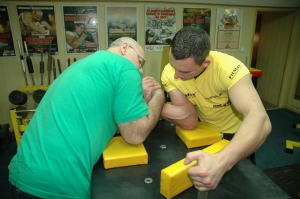
After stopping the opponent’s arm move your shoulder forward, in order to shorten the angle between arm and forearm. Do not let your opponent’s attack move forward!

One of the most common mistakes when blocking the opponent’s arm and launching a counter is twitching your body backwards, thus widening the angle between forearm and arm. The best that can happen is that one loses this way, the worst – an acute injury.
HOOK COUNTER
What to do to your opponent after you’ve stopped their attack.
METHOD #1

In this instance, the fighter on the right started attacking and gained a little advantage over his opponent. However, the opponent managed to stop the attack.

The fighter on the left moves his shoulder forward, thus reducing the angle between arm and forearm.

The fighter on the left moves his elbow forward, at the same time raising the grip upwards.

He attacks his opponent’s arm with a side movement. In the end phase of this attack we apply pressure on the opponent’s arm with our forearm.
METHOD #2

The fighter on the right attacked first and gained advantage. The opponent managed to stop his advance. His elbow is on the lower right edge of the pad.

The fighter on the left moves his shoulder towards the grip, so as to tighten the angle between arm and forearm, at the same time applying pressure to his opponent’s arm by way of his hand.
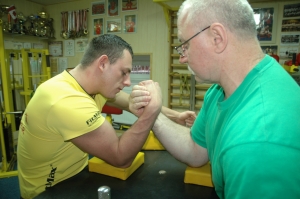
The fighter on the left moves his elbow forward, raising the grip upward.
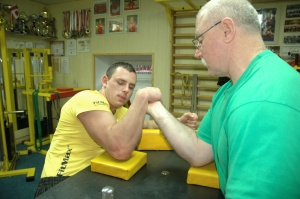
When your opponent loses his grip, rotate your wrist towards your body, rotating his at the same time.
The above technical elements are worth practicing every sparring. Perfect technique widens your fighting horizons.
INTERESTING, PRACTICAL AND USEFUL IN TRAINING
What to focus on during exercise.
Experience teaches us that not every exercise offers us a 100% possibility of strengthening different muscle parts. A typical exercise is a wrist bend using thick grip and regulated pulley (elbow on half-table).
HOOK TRAINING WITH REGULATED PULLEY AND THICK GRIP
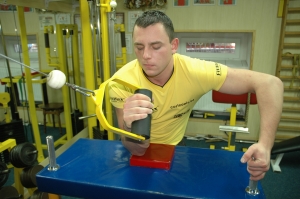

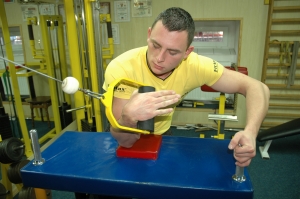
Notice that in the end phase of this exercise the trainee’s fingers are not engaged at all, they are not gripping the handle. During a real fight fingers play a major role, but in this exercise we focus on strengthening the wrist, not the fingers. Notice that in armwrestling there are only a few exercises that influence one or two muscle parts. In a fight advantage is gained not by one muscle group, but many.
HOOK TRAINING WITH REGULATED PULLEY AND STRAP GRIP




The previous exercise proved to use that it pays to use different grips in wrist training. To increase pressure on fingers and wrist in every phase of the exercise, use a strap grip.
PROPER FORM OF STRAP GRIP EXERCISE

Before beginning exercise, wind the strap onto the grip a little, to put more pressure on your fingers.
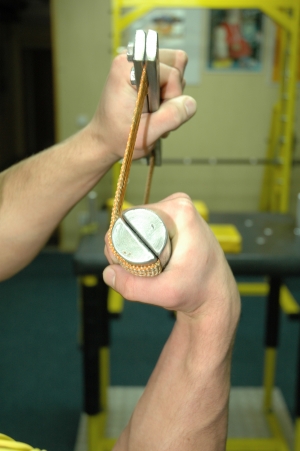
Performing a wrist bend, use your fingers too.

Never loosen your fingers in this exercise.
FORTIFYING YOUR DEFENCE IN HOOK



Exercising biceps using thick grip and regulated pulley (elbow on half-table) activates our bicep and elbow fastenings, and gives us the advantage when stopping the opponent’s attack. In the end phase of this exercise, the fingers are not engaged – it’s a huge drawback of this exercise.



Using a strap grip we activate our fingers.
WORKING WITH EXPANDERS



Remember to warm up properly before any exercise. A good exercise to warm up elbows, fastenings, forearm and arm muscles, as well as exercising hook is work with expanders, as they simulate real fight conditions quite accurately.
Remember that all the above is connected to your safety and proper form of exercise. We will return to the hook many times in the future. Please share with us your experiences from Zloty Tur on armpower.net.
Edit. staff

